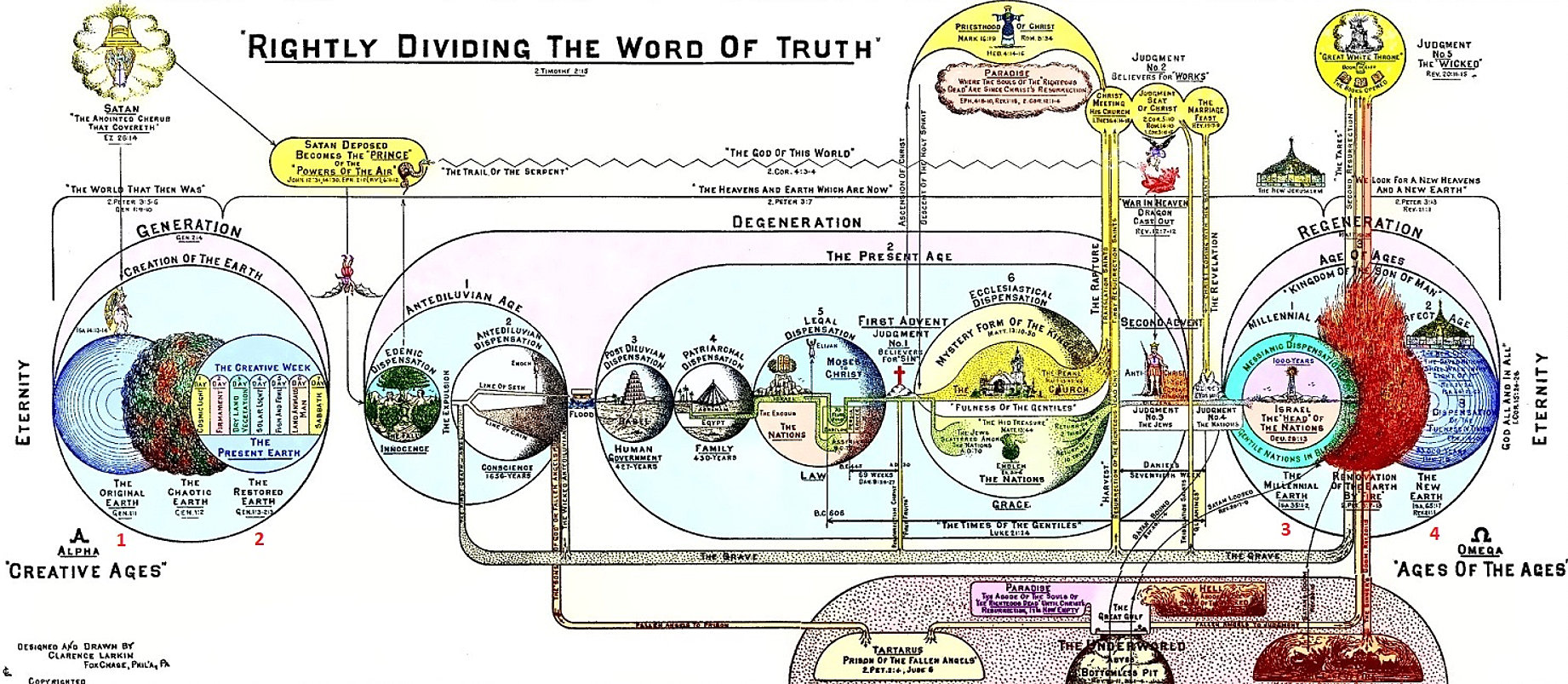One Pattern of History – Dispensations
Ages and Dispensations According to Clarence Larkin
The chart above (click on chart to enlarge in another tab) and text below are drawn from Clarence Larkin’s influential book, Dispensational Truth, first published in 1918 based on the teachings of John Nelson Darby (see below) and augmented with his own studies. His work and diagrams have since passed into the public domain and are available online here. If you are fascinated by the chart, you can find an accurately redrawn version of it, complete with Bible links here.
The Chart is divided into 3 “Ages,” corresponding to the Divine number “Three” (Father, Son and Holy Spirit) ; and into 7 “Dispensations,” to correspond to the Perfect number “Seven” composed of the Divine number “Three” and the World number “Four” -Winter Spring, Summer and Autumn, or the four elements, Earth, Air, Fire and Water.
An “Age” in Scripture is from one “cataclysmic” or “climatic” change to another in the earth’s surface or condition. This corresponds to what is called in Geology an “Age.” So we see that Science and the Bible agree as to the meaning of the word “Age.”
The difference between an “AGE” and a “DISPENSATION is that an “AGE” stands for a period between two great physical changes in the earth’s surface, while a “DISPENSATION” stands for a “moral” or “probationary” period in the world’s history. The form of “Administration” is different in each “Dispensation.” For illustration, the Administration of the Jewish Dispensation was that of “LAW,” the Administration of the present Dispensation is of “GRACE,” and of the one to follow is “RIGHTEOUSNESS.”
But it is not enough to classify the Scriptures in the manner already mentioned; we must learn to separate the Scriptures as to “TIME” and “ETERNITY” and the different “AGES” and “DISPENSATIONS” of “Time.” A reference to the Chart “RIGHTLY DIVIDING THE WORD” will reveal the fact that outside of “TIME” the Scriptures mention “TWO AGES:” before “Time,” the “ALPHA” or “CREATIVE AGES, ” and after “Time,” the “OMEGA” or “AGES OF THE AGES.” In “Time” there are three “AGES” and seven “DISPENSATIONS.”
Ages and Dispensations
ALPHA (before time) |
Creation and Restoration of the Earth |
AGES OF TIME |
DISPENSATIONS |
1. THE ANTEDILUVIAN AGE.This extends from the “Fall” to the “Flood.”
|
1. The Edenic Dispensation (Innocence). 2. The Antediluvian Dispensation (Conscience). |
2. THE PRESENT AGE.This extends from the “Flood” to the “Second Coming of Christ.” |
3. The Post-Diluvian Dispensation (Human Government). 4. The Patriarchal Dispensation (Family). Also called the Dispensation of Promise by some. 5. The Legal Dispensation (Law). 6. The Ecclesiastical Dispensation (Grace). Tribulation (Judgment). |
3. THE AGE OF AGES.This extends from the “Second Coming of Christ” to the “End of Time.” This last “Age” is a “Dual Age” composed of:
|
7. The Millennial Age (Righteousness). |
OMEGA (after time) |
The Perfect Age (Holiness). |
HisKingdom.Us Note:
There are many ways of presenting the thought-provoking exegetical thesis of contemporary Dispensationalism, first propounded extensively by John Nelson Darby around 1830, of which the outline derived from Larkin above is a typical and clear representation. There are a number of contemporary churches that adhere to Dispensationalism, in one form or another, as part of their doctrine of the church as expounded upon in this article by William Wenstrom.
A deeper study of the thesis and doctrines that have emerged from it reveals a number of similarities and several differences between the Biblical perspective of this website and that of Dispensationalism. Overall, we agree with Dispensationalists and others in seeing a progressive revelation of God’s character, plan, and purposes in the Biblical record that unfolds in time from Genesis through Revelation. In this regard, we are in harmony with them in endorsing the different dispensational concepts they describe in keeping with a premillennial view of the end of the age. However, we sense that Dispensationalism as a doctrine may be too cut-and-dried an exposition of God’s dealings with mankind to adequately reveal the consistency of His grace at work throughout history, as mentioned in our discussion of the Pattern (or Stages) of History. In summary, we have the following specific differences:
1. Alpha – Dispensationalism hypothesizes a “gap” in the creation story between the first two verses of Genesis 1 as an explanation for the differences between the account given by geological science and a literal 7-day reading of scripture. This proposes that God created the universe in an unknown period of time in Genesis 1:1 and then “restored” it in 7 solar days’ time starting in Genesis 1:2. Others, including Watchman Nee, have held a similar view. Our view is that the Genesis account is more readily reconciled with the scientific record by noting the linguistic ambiguities in Scripture that refer to the passage of time and creation of mankind.
2. Kingdom – Dispensationalism clearly distinguishes the Jewish people and Israel of the Old Testament from the “Ekklesia” or Church of the New Testament and carries this distinction up through today and into the future. Our perspective places more emphasis on our unity in living faith and the progressive adoption of Gentiles into the Kingdom of God (“spiritual Israel”), accompanied by the progressive revelation of the Messiah to the Jewish people as history unfolds.
3. Omega – Dispensationalism reserves the experience of the Great Tribulation (a prophetic period of intense judgment visited on the world for the seven years just prior to the Second Coming of Christ) for the unsaved of the world with a special focus on the Jewish people and Jewish state during this time and in the Millennium to follow. We have a difficult time finding consistent Scriptural warrant for placing the resurrection of those believers who have died in faith (also known as “The Rapture”) at the onset of the Great Tribulation, rather than simultaneously with the return of Christ and the establishment of His Millennial Kingdom as proposed by the Historic Premillennialism which we endorse.

 Kingdom Insights #6
Kingdom Insights #6 
God’s Timing. We’ve already seen that the God of the Universe, who dwells in Eternity, has a rather elastic way of dealing with the dimension of reality that He created called Time. He doesn’t always measure “a day” as the time it takes for our earth to complete one rotation on its axis (as if this has always been the same). Nor does He necessarily number epochs in accordance with our tidy conceptual ways of subdividing human history. We need to exercise great caution when we try to fit Him and His Ways into boxes of our own creation: His ways are higher than ours, and we are bound to leave important understandings out if we get too clever.
“The LORD has established His throne in the heavens, and His kingdom rules over all.” Psalm 103:19
Navigation Notes
Look below and you’ll notice Up and Down buttons in the middle. Using these buttons you can navigate directly through the timelines we’ve developed for this website. For each timeline we will take a detailed tour using the outside buttons to investigate historical events and people noted on the current chart (the preferred route, especially for your early visits to our website). Our upcoming Chart 2 tour will allow us to look more closely at the lives and times of the Ancient Patriarchs in Genesis in the context of concurrent events in world history. Before we do that, however, let’s move on from this discussion of Dispensationalism to investigate the subject of historical timelines in general and the difficulties they present.

